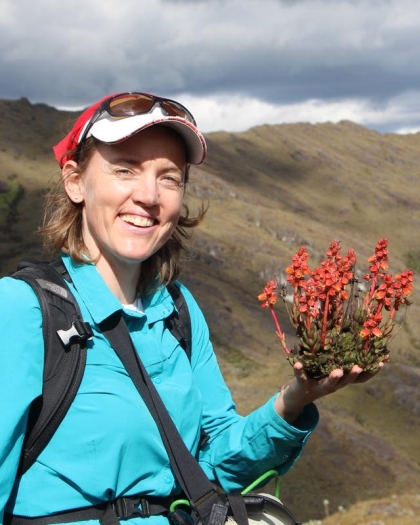
Researcher in Global Change Ecology affiliated with the Terrestrial Ecology, and leader of the Mountains in Motion research groups within the Department of Biological Sciences and the Bjerknes Centre for Climate Research at the University of Bergen. Dr. Suzette Flantua's research interests include:
- Integrate biogeography, paleoecology, landscape ecology, and spatial analyses to gain new insights into the drives of global mountain biodiversity over short and long time scales.
- Responses of biodiversity to past and future climate change and humans, with special emphasis on mountain systems and alpine ecosystems.
Research Projects
Past, Present and Future of Alpine Biomes Worldwide (PPF-Alpine): Elucidating the Quaternary history (last 2.6 million years) of alpine biomes, based on the notion that their dynamic past may hold key insights for their future resilience. Hence, looking into the past can provide the empirical foundation for anticipating ecological responses to global warming and perhaps provide evidence for a more optimistic Future. To decipher the biogeographical history of alpine diversity, PPF-Alpine has two underlying principles:
- We incorporate cross-disciplinary lines of research into one joint research project integrating expertise, tools, and data from paleoecology, biogeography, macroecology, and landscape modelling. This integration is essential to address one of the most important questions in biogeography, namely… ‘What causes global patterns of alpine biodiversity?
- We promote research that acknowledges and quantifies the legacy of long-term dynamics of the past in present-day biodiversity.
GLACIMONTIS: Understanding the extent of mountain glaciers during past cold periods, with a focus on the Last Glacial Maximum (~21,000 years ago) and the last glacial cycle (the last 130,000 years). The project reconstructs glaciers in mountains worldwide with cutting edge techniques and compiles paleoglacier reconstructions from published studies into a global open-access geodatabase, integrating geomorphological mapping, chronological data, and glacier modelling outputs. This resource allows researchers to analyse past ice cover at regional to global scales, refine climate and glacier models, and assess the role of glaciation in shaping mountain environments. Beyond compiling existing data, GLACIMONTIS also develops new reconstructions in poorly studied regions, advancing our understanding of past cryosphere–climate interactions.
Ecological Spatial Competence and Education (ECO-SPACE): New course for our students at BIO and UiB to address a critical gap in Norway’s higher education: the lack of geospatial training for biology and environmental science students that integrates Universal Design (UD) principles. The course will combine GIS, Remote Sensing, and spatial analysis with ecological and environmental applications, ensuring that students learn to create accessible, inclusive, and impactful geospatial products. Course content will be built from BIO research projects, stakeholder case studies, and collaborations with national and international partners. ECO-SPACE will also serve as a platform for collaboration—through workshops with UiB researchers, stakeholders, and industry—to co-develop high-quality teaching modules and build capacity in UD and geospatial methods. In the long term, the course will contribute to national and international efforts to promote inclusive geospatial education for ecology and environmental management.
CONNECT-EVOLVE: The páramo, a unique high-altitude ecosystem in the northern Andes, is home to some of the most diverse and rapidly evolving plant communities in the world. Our project investigates how past climate change and landscape connectivity have shaped the extraordinary biodiversity found here today. By combining expertise in ecology, evolutionary biology, and climate science, and using innovative modelling approaches alongside comprehensive plant datasets and their evolutionary trajectories, we aim to uncover the historical processes that drive species diversity in tropical mountain systems. The insights gained will not only help safeguard the páramo flora but also provide valuable tools for conserving other vulnerable mountain ecosystems worldwide. In collaboration with Charles University in Prague and Royal Botanical Garden in London.
GEOBRIDGE - UiB collaborative platform for GIS/RS methods in landscape analysis in a changing world: Seminar series and other academic events related to GIS and RS, and landscape dynamics across the biosphere, geosphere, and cryosphere. Students from diverse academic background can united to tackle today's global environmental challenges and dive into essential tools for research and real-world problem-solving.
Global Human Impact Project: Our mission is to uncover the profound relationship between human activity and ecological processes during the Holocene. Through meticulous data compilation and analysis, we aim to shed light on how past humans have shaped terrestrial ecosystems. From studying pollen records and climatic variations to detecting indicators of human presence, our project delves into the intricate interplay of nature and human influence during the Holocene. Subprojects include the Anthropogenic pollen indicators: global food plants and Latin American human indicators in the pollen record, Humans impacts in Amazonia, and Humans on Planet Earth (HOPE).
Pantropical Dynamics: The Pantropical Dynamics is a collaborative network that unifies researchers interested in ecosystem dynamics across Latin America, Africa, and the Indo-Pacific regions. This intercontinental initiative is committed to unraveling the complexities of vegetation ecosystem dynamics since the Last Glacial Maximum (c. 22 ka) using compilations of fossil pollen records. Our forthcoming publications include continental-scale synthesis of vegetation dynamics of Latin America, Africa, and Indo-Pacific, while we also have individual projects running as part of PhD projects.
Fossilpol Workflow: The goal of the FOSSILPOL project is to make it easier for the interdisciplinary researcher to work with big fossil pollen databases. We developed a paper, workflow and R-package to process multiple fossil pollen records to create a comprehensive, standardised dataset compilation, ready for multi-record and multi-proxy analyses at various spatial and temporal scales.
Latin American Pollen Database (LAPD): Latin American Pollen Database project Twitter Website Since 2009 I have been leading the Latin American Pollen Database (LAPD) and I have been part of Neotoma Paleoecology Database and Community. I've facilitated the upload of pollen records to Neotoma from Latin America, and also from Europe and the Indo-Pacific region, together with several collaborators associated to the European Pollen Database and Neotoma.